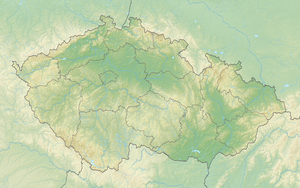Zelená hora (Nepomuk)
| Zelená hora | ||
|---|---|---|
| height | 536 m nm | |
| location | Plzeňský kraj , Czech Republic | |
| Mountains | Nepomuk hill country | |
| Coordinates | 49 ° 29 '47 " N , 13 ° 34' 54" E | |
|
|
||
| particularities | Zelená Hora Castle , Church of the Assumption | |
The Zelená hora ( Green Mountain ) is a striking elevation in the Nepomuk hill country (Nepomucká pahorkatina) in the Czech Republic . The Zelená Hora Castle and the Church of the Assumption of Our Lady are located on the mountain . The 533 m high mountain is located one kilometer north of the city of Nepomuk .
geography
The Zelená hora rises steeply above the confluence of the Mihovka in the Úslava . At its northern foot are the Klášterský rybník pond fed by the Úslava, the village of Klášter with the remains of the Nepomuk monastery and the Batov farm. To the northeast are the villages of Srby , Nehovice, Huť and Vrčeň , to the east the Vyskočilka inn, the Panský rybník pond and the place Dvorec. Nepomuk lies south of the mountain , and Borek farm to the south-west. Below the mountain in the west is the Mihovka valley with the Šternberk farm and a baroque bridge. Behind it rises the hill Na Skalici (561 m), at the foot of which the towns of Novotníky and Prádlo are located.
history
In pre-Christian times there was a pagan cult site of the Celts with a sacrificial stone and an altar on the mountain.
Legend has it that St. Adalbert , when he returned from Rome in 977 with monks who are said to have blessed the people living below the mountain during a great drought. Then rain is said to have started and the withered mountain turned green. The residents are said to have named the place Pomuk in thanks for their help. During the blessing, Adalbert is said to have stood on the rock that now protrudes from the floor of the presbytery of the church.
According to ancient traditions, a hermit named Břímota or Bořita settled on the densely wooded mountain in the 11th century. He built a wooden chapel consecrated to the Virgin Mary under the Green Mountain, in the place of which the Pomuk Monastery was built in 1145 . The mountain belonged to the monastery property and the monks built a watchtower on it. King Ottokar I Přemysl had a fortification built on the Green Mountain in 1221. Nothing is known about this complex and no remains have been preserved. It probably lasted only a short time.
In 1419 the Hussite leader Mikuláš z Husi a Pístného occupied the mountain, which again belonged to the monastery, and had a fortified courtyard built as his seat, which he called Hora Olivetska ( Mount of Olives ). A short time later, the Schwanberger captured the Hussite seat and destroyed it. In 1436, Hynek Krušina von Schwanberg built Grünberg Castle on the mountain , which became the seat of a secular rule encompassing the goods of the destroyed monastery. In 1449, in the sacristy of the castle chapel, the Bohemian crown insignia, including the Wenceslas crown, were kept during their transfer from Karlštejn Castle to Velhartice Castle.
Zdenko von Sternberg had the castle chapel demolished in 1464 and the church of St. Build Adalbert. Under Adam von Sternberg , what is probably the oldest waterworks in Bohemia was built, which pushed the water drawn from the former monastery mill into the well in the forecourt of the castle via a system of wooden pipes. Wenzel Adalbert von Sternberg had the castle complex redesigned into an early baroque palace between 1670 and 1688. From 1688 he began to expand the church to a three-aisled pilgrimage church.
Between 1939 and 1990 the army used the castle and the Šternberk farmyard at the foot of the mountain. The castle and church were plundered during this period and little was done to preserve them. The main altar of the Church of the Assumption of the Virgin was given to the Church in Neurazy during this period . The intended repatriation did not come about because of the looting of the Neurazy church in 2003, during which the altar was also robbed.
Inside the church there has been an exhibition by the sculptor Václav Fiala under the motto “Stavby ve stavbě”, which shows a wooden Christian rotunda and an Islamic minaret, since May 2003.
Attractions
- Zelená Hora Castle , the castle built in 1436 was converted into a chateau in 1670 and 1688
- Church of the Assumption of Mary, the church built in 1464 instead of the castle chapel was expanded into a three-aisled pilgrimage church in 1688.
- Vyskočilka inn, at the wayside cross, east below the mountain
- Statue of St. John of Nepomuk south of the Vyskočilka
- Šternberk farm, built before 1584 as a fortified farm at the western foot of the mountain, in 1669 the outwork with the brewery and stables for young horses was renewed
- Obelisk near the Vyskočilka, in memory of the English soldiers of Elisabeth Stuart's escort , who died on October 6, 1620 in a battle with Bavarian troops

